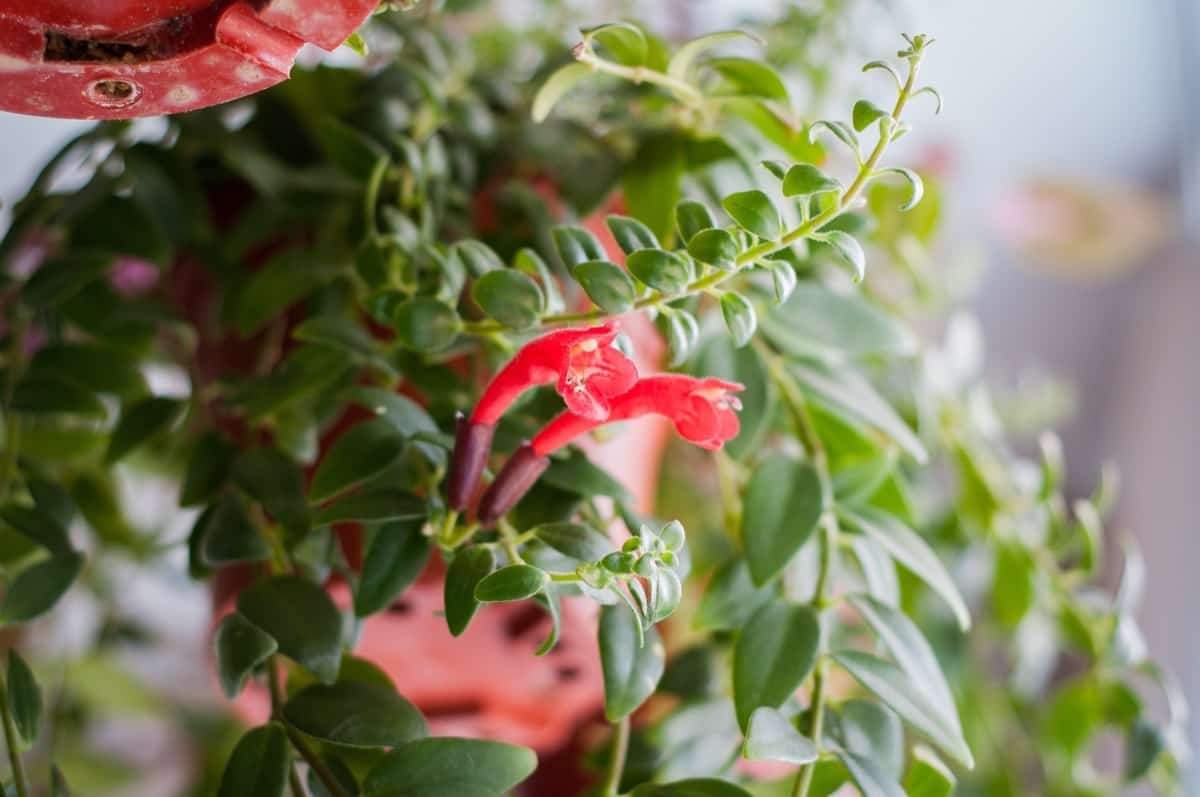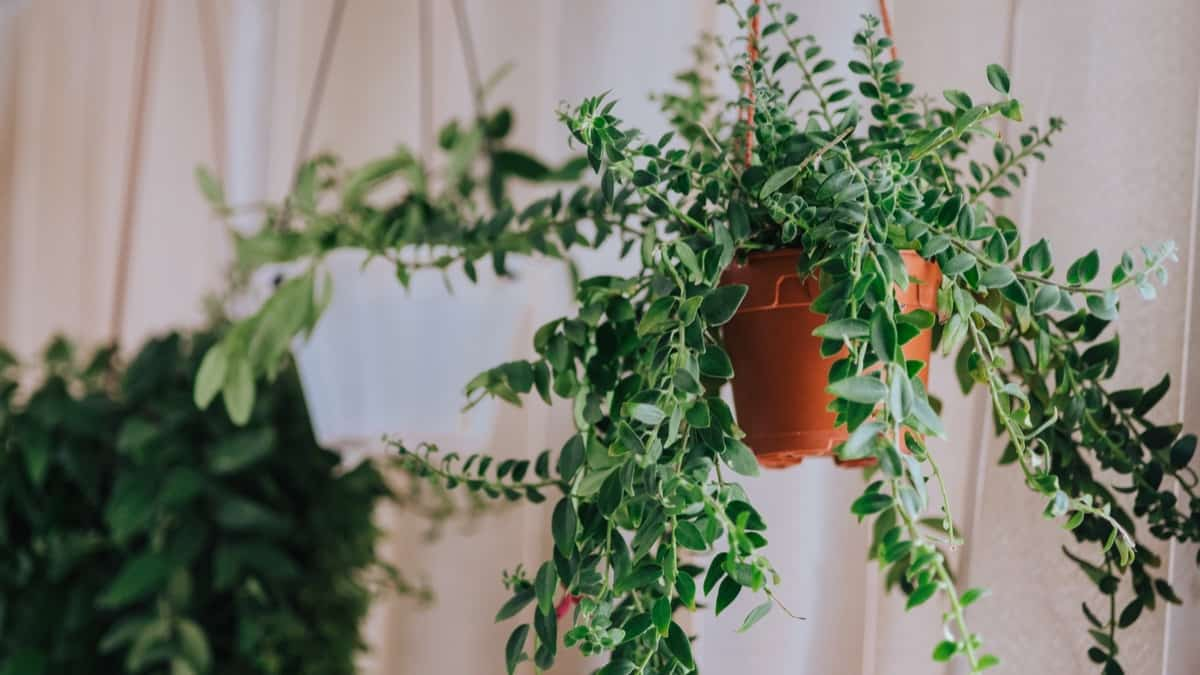The Lipstick Plant is a stunning tropical houseplant that adds color and vibrancy to any indoor space. With their glossy green leaves and cascading vines, Lipstick Plants make for eye-catching displays when placed in hanging baskets or on shelves. One fascinating aspect of the Lipstick Plant is its ability to attract hummingbirds with its vibrant red or orange tubular flowers.

These blooms bloom throughout the year and provide an added touch of natural beauty to your home. These tropical beauties bring a touch of exotic charm to any indoor space and can easily become your new favorite houseplant.
Lipstick Plant Care
Varieties/types of Lipstick Plants
Black Pagoda Lipstick Plant – This plant features beautiful deep red flowers resembling a richly pigmented Lipstick tube. However, what sets this particular variety apart is its unique black foliage. The Black Pagoda Lipstick Plant leaves are a dark shade of purple-black, adding an intriguing and dramatic element to any space it inhabits.
Curly Lipstick Plant – The Curly Lipstick Plant is a stunning variety that adds a whimsy touch to any indoor space. This plant will surely stand out in your collection with its unique curly leaves and vibrant red flowers. One of the most striking features of the Curly Lipstick Plant is its foliage. The leaves are curled and twisted, giving them an intriguing appearance that differentiates them from other varieties.
Krakau Lipstick Plant – The Krakau Lipstick Plant is a stunning variety that adds elegance to any indoor space. Its vibrant red flowers and glossy green foliage will surely catch the eye of anyone. One unique feature of the Krakau Lipstick Plant is its ability to adapt to lighting conditions.
Tangerine Lipstick Plant – Tangerine Lipstick Plant is a vibrant and eye-catching variety that adds color to any space. With its bright orange flowers resembling the shade of juicy tangerines, it’s hard not to be captivated by this stunning plant.
Choosing the Right Location for Your Lipstick Plant: Light, Temperature, and Humidity
Choosing the right location for your Lipstick plant is crucial for its health and growth. These tropical beauties thrive in bright, indirect light, so find a spot near a window with filtered sunlight. Lipstick plants prefer warm temperatures between 15-24°C. Keep them away from drafts or cold windows during winter months to prevent damage.
Humidity is another key factor to consider. These plants love humidity levels around 50-60%. If you live in a dry climate, use a humidifier or place your Lipstick plant on a tray filled with pebbles and water to provide extra moisture. Remember to rotate your Lipstick plant every few weeks to ensure even growth and prevent it from leaning toward the light source. This will help maintain its symmetrical shape.
Watering Techniques for Lipstick Plants: Frequency, Amount, and Drainage
Lipstick plants prefer moist but well-draining soil, so striking the right balance is important. How often to water the Lipstick plant? Generally, you should water your Lipstick plant when the top inch of soil feels dry. This usually translates into watering once or twice a week, depending on the environmental conditions. When watering your Lipstick plant, be sure to soak it thoroughly.
However, be cautious not to overwater your Lipstick plant, which causes root rot and other problems. Always allow excess water to drain away completely, and never let your plant sit in standing water. In addition to frequency and amount, proper drainage is also essential for watering success. Lipstick plants dislike soggy roots, so ensure their pots have sufficient drainage holes.
Fertilizing Your Lipstick Plant: Best Practices and Recommended Products
First and foremost, choose a high-quality fertilizer specifically formulated for houseplants. To keep your Lipstick plant healthy and vibrant, it’s important to fertilize regularly during the growing season. Typically, this means applying fertilizer every two weeks from spring through summer. However, be sure to follow the instructions on the product packaging, as different brands may have varying recommendations.
Always dilute fertilizer according to the package instructions when applying fertilizer to your Lipstick plant. Over-fertilizing can lead to root burn and other issues. It’s better to err on caution and use slightly less than recommended rather than risk damage. In addition to using a balanced liquid fertilizer, consider supplementing with organic options such as compost or worm castings. These natural alternatives provide slow-release nutrients that nourish your Lipstick plant without the risk of overfeeding.
Pruning and Training Techniques for a Healthy and Beautiful Lipstick Plant
By following the right techniques, you can help your plant grow in a controlled manner and encourage it to produce more vibrant blooms. Remove any damaged leaves or stems when it comes to Lipstick plant pruning. Another important aspect of pruning is shaping the plant. You can trim back long vines to promote bushier growth or train them to climb up supports using moss poles or trellises.
This will create an attractive display and prevent the plant from becoming leggy. Always use clean and sharp tools to make precise cuts to ensure successful pruning. It’s recommended to disinfect your tools between each cut to minimize the risk of transmitting diseases. Remember that while pruning benefits your Lipstick plant, overdoing it can be detrimental. Avoid excessive trimming, as it may stunt its growth or inhibit flower production.
Preventing and Managing Common Pests and Diseases in Lipstick Plants
One of the most common issues faced by Lipstick plants is aphids. These tiny insects feast on tender new growth and leave behind a sticky residue. Start by regularly inspecting your plant for signs of infestation to combat them. If you spot aphids, wash them off with a gentle water stream or treat the affected areas with insecticidal soap. Another pesky pest that can bother your Lipstick plant is spider mites.
These minuscule creatures thrive in dry conditions, so maintaining adequate humidity around your plant is key to keeping them at bay. You can also use neem oil, dish soap, and water mix to control unwelcome guests. Fungal infections like powdery mildew or black spots can also plague Lipstick plants.
In case you missed it: A Guide to Growing Mexican Bird Of Paradise from Seeds: Pruning, Propagation, and Care

To prevent this from happening, ensure good air circulation around your plant by avoiding overcrowding it with other foliage. Additionally, avoid overwatering, as excessive moisture can create a favorable environment for fungal growth. Regularly inspecting your Lipstick plant’s leaves for any signs of discoloration or unusual spots will help catch potential problems before they become major.
Repotting Your Lipstick Plant: When, How, and What Soil Mix to Use
Regarding timing, the general rule is to repot your Lipstick plant every 1-2 years or when you notice it has outgrown its current pot. Signs that repotting is needed include roots poking out of drainage holes or becoming tightly bound in the pot. Remove the plant from its current container.
Carefully loosen any compacted roots and trim away any dead or damaged ones. Select a new pot slightly larger than the previous one to allow for growth. As for soil mix, Lipstick plants prefer a well-draining medium. Equal parts peat moss, perlite, and orchid bark work well. This mixture provides good drainage while retaining enough moisture for healthy root development.
Once you have chosen your soil mix, place a layer at the bottom of the new pot before carefully positioning your Lipstick plant. Fill around the sides with more soil mix until secure but not overly compacted. After repotting water, thoroughly settle the soil and eliminate air pockets around the roots. Then resume regular watering according to your plant’s needs.
Propagating Lipstick Plants: Methods for Successful Plant Multiplication
One popular method for Lipstick plant propagation is through stem cuttings. To start, select a healthy stem with at least two nodes. Make a clean cut just below a node using clean scissors or pruning shears. ip the cutting end in a rooting hormone powder. This step is optional but can significantly increase success rates. Once coated, gently insert the cutting into moist potting soil or water until roots form.
Another method is layering, which involves bending one of the stems downward and securing it in contact with soil using small stakes. Over time, new roots will develop along this buried section of stem. Some gardeners have had success propagating Lipstick plants by division. Remove the plant and separate it into multiple sections, ensuring each division has enough roots. Remember to provide proper care after propagation by placing newly rooted cuttings in bright indirect light and keeping them consistently moist but not overly wet.
Why is My Lipstick Plant Turning Yellow and Drooping?: Find the Causes and Fix It
One possible cause of yellowing leaves and drooping stems is overwatering. Lipstick plants prefer moist but well-draining soil, so if you’ve been showering it with too much water, it’s time to scale back. On the other hand, underwatering can also lead to yellowed leaves and wilting stems. If you’ve neglected your Lipstick plant’s water needs, increase your watering frequency slightly while ensuring the soil is not overly soggy.
Insufficient light exposure may also contribute to yellowing foliage. Lipstick plants thrive in bright indirect light, so consider moving yours closer to a window or providing supplemental grow lights if needed. Another potential culprit behind a sickly-looking Lipstick plant is nutrient deficiency. Ensure you’re using a balanced fertilizer specifically formulated for houseplants, and follow the instructions on how often to feed your plant.
Why is My Lipstick Plant Dying?: What Causes It and How to Fix It?
One common cause of a dying Lipstick plant is improper watering. Overwatering or underwatering can both lead to problems. If you notice yellow leaves or soggy soil, you’re likely overwatering. On the other hand, if the leaves are dry and crispy, you may need to provide more moisture. Another factor to consider is light exposure. Lipstick plants thrive in bright but indirect light.
Lack of proper nutrition could also be contributing to your plant’s decline. Ensure you use a balanced fertilizer formulated for houseplants every few weeks during the growing season. Mealybugs and spider mites can also wreak havoc on your Lipstick plant, causing wilting and leaf damage. Check the overall health of your plant’s roots by gently removing it from its pot. If you notice root rot or an overly compacted root ball, it’s time for repotting using well-draining soil.
In case you missed it: Foliage Plant Care: Pruning, Repotting, Fertilizing, and Propagation

Conclusion
Taking care of a Lipstick Plant can be a rewarding and fulfilling experience. These plants can brighten up any space with stunning blooms and lush foliage. Caring for a Lipstick Plant is crucial to its health and growth, from propagation to pruning, fertilizing to repotting. By understanding your plant’s specific needs and providing it with the right conditions, you can enjoy its beauty for years.
- Feed Your Flock for Less: Top 10 Tips to Save on Chicken Feed
- Ultimate Guide to Ossabaw Island Hog: Breeding, Raising, Diet, and Care
- Hatching Answers: The Top 10 Reasons Your Chickens Aren’t Laying Eggs
- Eggs and Economics: Breaking Down the Cost of Raising Backyard Chickens
- Defend Your Greens: Proven Methods to Keep Iguanas Out of Your Garden
- Ultimate Guide to Cinnamon Queen Chicken: A Comprehensive Guide for Beginners
- Ultimate Guide to California Tan Chicken: Breeding, Raising, Diet, Egg-Production and Care
- Ultimate Guide to Marsh Daisy Chicken: Breeding, Raising, Diet, and Care
- 10 Types of Chicken Farming Businesses You Can Start for Profits